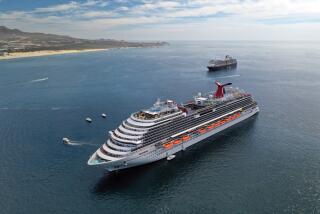Forming a Strong Protective Bond : Cruise lines: A proposal would raise the amount companies have to pledge to protect passengers against cancellations. But consumers may pay the price for the extra security.
- Share via
Suppose you pay for a cruise and then the sailing doesn’t take place? How much protection do you have for your money?
Beefing up protection is in the offing for some sailings, although the cost of such extra security might be passed to the consumer.
At present, cruise lines that take on passengers in U.S. ports, and carry at least 50 passengers on their ships, must--under federal law--file a bond or other financial proof with the Federal Maritime Commission, assuring full refunds if sailings are canceled.
The current lid for surety bonds or other financial proof is $10 million. But the FMC thinks this amount might be inadequate for some larger lines, and so has a proposal to remove the lid and have the bond go as high as needed.
Several factors played a part in proposing that the level of protection be raised, including inflation and some key changes in the marketplace affecting cruises, all of which add up to the cruise lines holding more and more consumer funds for future sailings.
For starters, more cruise ships are operating now. Many more ships have been built, while other vessels have been stretched and renovated to increase passenger capacity. And new liners are under construction.
In addition, there has been consolidation among the cruise lines. Lines usually used to have only have a few ships, but today some have substantial fleets.
There has also been a general increase in fares, with rates tending to go up annually. Many passengers plunk down their money for cruises months ahead of sailing dates. Most lines want full payment at least 30 days before sailing.
Another factor is that many cruise lines offer early booking options, with financial incentives for travelers to make their reservations months in advance of sailing dates.
“More and more passengers are booking early to take advantage of these types of plans,” said Rod Seeley, president of Cruise Pro, a Westlake Village agency specializing in cruises, and a first vice president of the New York-based National Assn. of Cruise Only Agencies.
The FMC proposal also calls for more stringent reporting rules about how much money in passenger funds that cruise lines hold for future voyages. Now, lines covered by the FMC have to file such a report for six-month periods. If the proposal is approved, this requirement would be amended so that lines would have to file a statement for each month during that period.
The proposal also calls for periodic adjustment of the bond amount, based on money received for future sailings.
Critics of the FMC plan believe that large lines are unlikely to go out of business, thus the real danger is pricing out small start-up companies from entering the cruise market, thereby reducing competition.
“Larger companies might need larger bonds,” said Bryan Van Brakle, an FMC spokesman. “Technically, there’s no cap. It depends on the unearned revenues each cruise line is holding.”
On this basis, larger lines might have to post bonds that could go up to $25 million or $50 million, said Art Rodney, president of Los Angeles-based Crystal Cruises. “The amount of the bond could be astronomical. Maybe $10 million is too low in today’s market, but I’m not in favor of an open-ended bond. You can’t protect every dollar. The bond has to be realistic. As the bond goes up, the consumer will pay for it. That’s for sure.”
Agreed Seeley: “Higher bonds will mean more secure deposits for consumers, but on the negative side it will raise tariffs to offset the cost of the bonds.”
“I don’t see the need for raising the level,” said Warren Titus, head of San Francisco-based Seabourn Cruise Line. “I think it’s overkill. I think $10 million is adequate for the type of problems we’ve seen in the past. The bigger lines are financially sound, and it’s very remote that any would go under. It’s the smaller, newer entries that haven’t succeeded.”
Arguing that the larger bonds “can only help consumers,” Michael Grossman, president of Cruises of Distinction, a Montclair, N.J., cruise discount company, added: “There have been cases where lines have stopped operations and consumers have gotten less than 100 cents to the dollar. If the cost is passed on to the consumer, it’s still worth having the extra protection. But it’s really the small and new lines that need attention, not the big lines.
“Higher bonds will raise the barrier entry for new cruise lines, but if getting a bond is a problem, they shouldn’t be in business in the first place. The bond is a small element of the total investment of starting a cruise line.”
Remember that ships that don’t pick up passengers at U.S. ports are not regulated. For example, if you go on an air-sea cruise, for instance fly to Lisbon to embark on a Mediterranean sailing, you’re not necessarily protected by the FMC-imposed bond if your ship fails to leave port for some reason.
“We don’t have jurisdiction,” Van Brakle said.
Other sailings, from one foreign port to another, including ports of call in the Caribbean, are filled with American passengers whose payments for these cruises may not be covered by the financial proof required by the FMC.
Said Brakle: “A passenger could fly from Miami to Jamaica and then sail on a cruise to other Caribbean ports and South America without being subject to the FMC.”
The general public has until April 4 to send in comments on the FMC proposal. Write to Joseph C. Polking, Secretary, Federal Maritime Commission, Docket 90-1, 1100 L St. N.W., Washington, D.C. 20573.
More to Read
Sign up for The Wild
We’ll help you find the best places to hike, bike and run, as well as the perfect silent spots for meditation and yoga.
You may occasionally receive promotional content from the Los Angeles Times.






